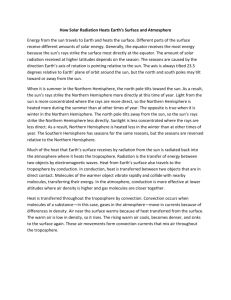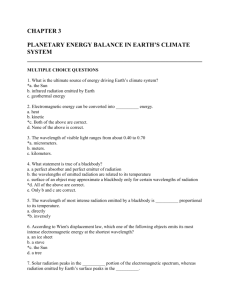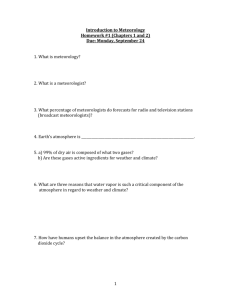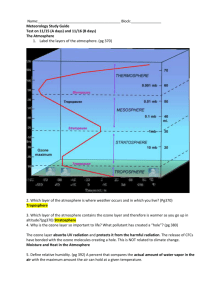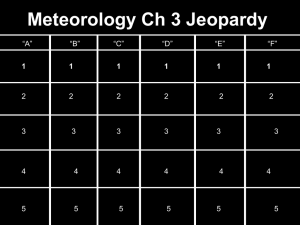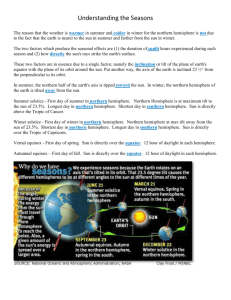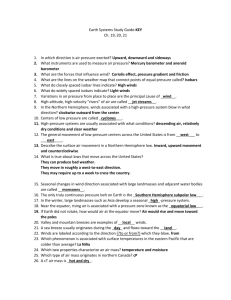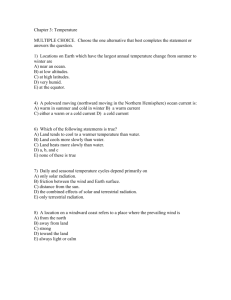G312 Midterm Sample Qs - Cal State LA
advertisement
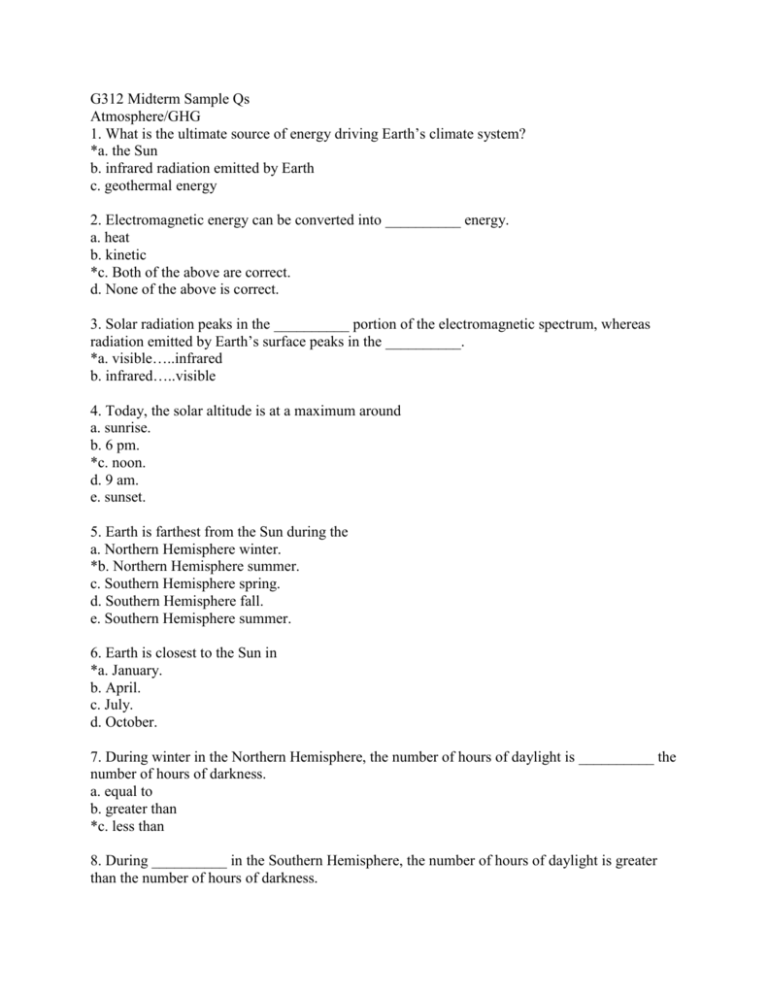
G312 Midterm Sample Qs Atmosphere/GHG 1. What is the ultimate source of energy driving Earth’s climate system? *a. the Sun b. infrared radiation emitted by Earth c. geothermal energy 2. Electromagnetic energy can be converted into __________ energy. a. heat b. kinetic *c. Both of the above are correct. d. None of the above is correct. 3. Solar radiation peaks in the __________ portion of the electromagnetic spectrum, whereas radiation emitted by Earth’s surface peaks in the __________. *a. visible…..infrared b. infrared…..visible 4. Today, the solar altitude is at a maximum around a. sunrise. b. 6 pm. *c. noon. d. 9 am. e. sunset. 5. Earth is farthest from the Sun during the a. Northern Hemisphere winter. *b. Northern Hemisphere summer. c. Southern Hemisphere spring. d. Southern Hemisphere fall. e. Southern Hemisphere summer. 6. Earth is closest to the Sun in *a. January. b. April. c. July. d. October. 7. During winter in the Northern Hemisphere, the number of hours of daylight is __________ the number of hours of darkness. a. equal to b. greater than *c. less than 8. During __________ in the Southern Hemisphere, the number of hours of daylight is greater than the number of hours of darkness. a. winter *b. summer 9. Exactly one-half of the surface area of the Earth is in sunlight during a. either equinox only. b. the winter solstice only. c. the summer solstice only. *d. any day of the year. e. 1 January. 10. Earth's rotational axis is oriented perpendicular to the Sun's rays on the first day of *a. fall. b. winter. c. summer. d. All of the above are correct. e. None of the above is correct. 11. On the first day of summer in the Northern Hemisphere, the noon Sun has an altitude of 90 degrees where? *a. Tropic of Cancer b. Arctic Circle c. Tropic of Capricorn d. Antarctic Circle e. the equator 12. Except right at the poles, on the Earth nights are about 12 hours long when? a. aphelion b. perihelion *c. equinoxes d. solstices e. 1 July 13. At the equinoxes, the noon Sun has an altitude of 90 degrees at the a. north pole. *b. equator. c. Tropic of Capricorn. d. Arctic Circle. e. Tropic of Cancer. 14. Which location has the greatest change in daylight period over the course of a year? a. equator. b. Tropic of Capricorn. *c. Arctic Circle. d. Tropic of Cancer. 26. The __________ Hemisphere has a greater percentage of surface area covered by ocean, a. Northern *b. Southern 15. As solar radiation travels through the atmosphere, a portion of that radiation is a. absorbed by gases. b. reflected by clouds. c. scattered by dust particles and molecules. *d. All of the above are correct. e. None of the above is correct. 16. The layer of the atmosphere that contains the ozone shield is the a. troposphere. *b. stratosphere. c. mesosphere. d. thermosphere. 18. The principal threat to the ozone shield is (are) *a. chlorofluorocarbons (CFCs). b. automobile exhaust. c. burning of fossil fuels. d. volcanic eruptions. e. global warming. 19. The Antarctic ozone hole occurs during the Southern Hemisphere a. winter. *b. spring. c. summer. d. fall. 20. Which one of the following surfaces has the highest albedo for visible solar radiation? a. ocean water b. sand *c. fresh snow d. tropical rainforest e. old snow 21. The average albedo of the ocean is a. greater than that of clouds. b. greater than Earth's planetary albedo. *c. less than 10 percent. d. about 30 percent. e. more than 60 percent. 22. The troposphere is primarily warmed by a. absorption of solar radiation by clouds. b. scattering of solar radiation by aerosols. *c. heat transferred from Earth’s surface. d. absorption of solar radiation by ozone. e. heat transferred from the mesosphere. 23. The greenhouse effect is primarily the consequence of atmospheric *a. water vapor. b. nitrogen. c. oxygen. d. ozone. e. carbon dioxide. 24. At night, air temperatures near Earth’s surface tend to be highest when the sky is *a. completely cloud covered. b. partly cloudy. c. clear. 25. The Earth-atmosphere-ocean system would respond to an increase in planetary albedo by emitting __________ intense IR radiation to space. *a. less b. more 26. What is meant by temperature anomaly? *a. The amount that a temperature reading varies from an established baseline b. A sudden change in a temperature reading c. Refers to temperature extremes d. An error in a temperature reading 27. The ocean is a major sink for a. Carbon b. heat energy *c. both (a) and (b) d. neither (a) nor (b) 28. The cryosphere is the ____ portion of the hydrosphere. a. liquid b. gaseous *c. solid 29. About how much of the radiation from the sun striking the top surface of the atmosphere is reflected by the Earth’s surface and atmosphere? a. 10% * b. 30% c. 50% d. 75% 30. Why did the Charles Keeling’s carbon dioxide graphs show an up-and-down pattern each year? a. Measurement errors b. More carbon dioxide was generated by furnaces during the winter c. The air is denser in the winter, causing CO2 to become diluted *d. CO2 was absorbed each year during the growing cycle


